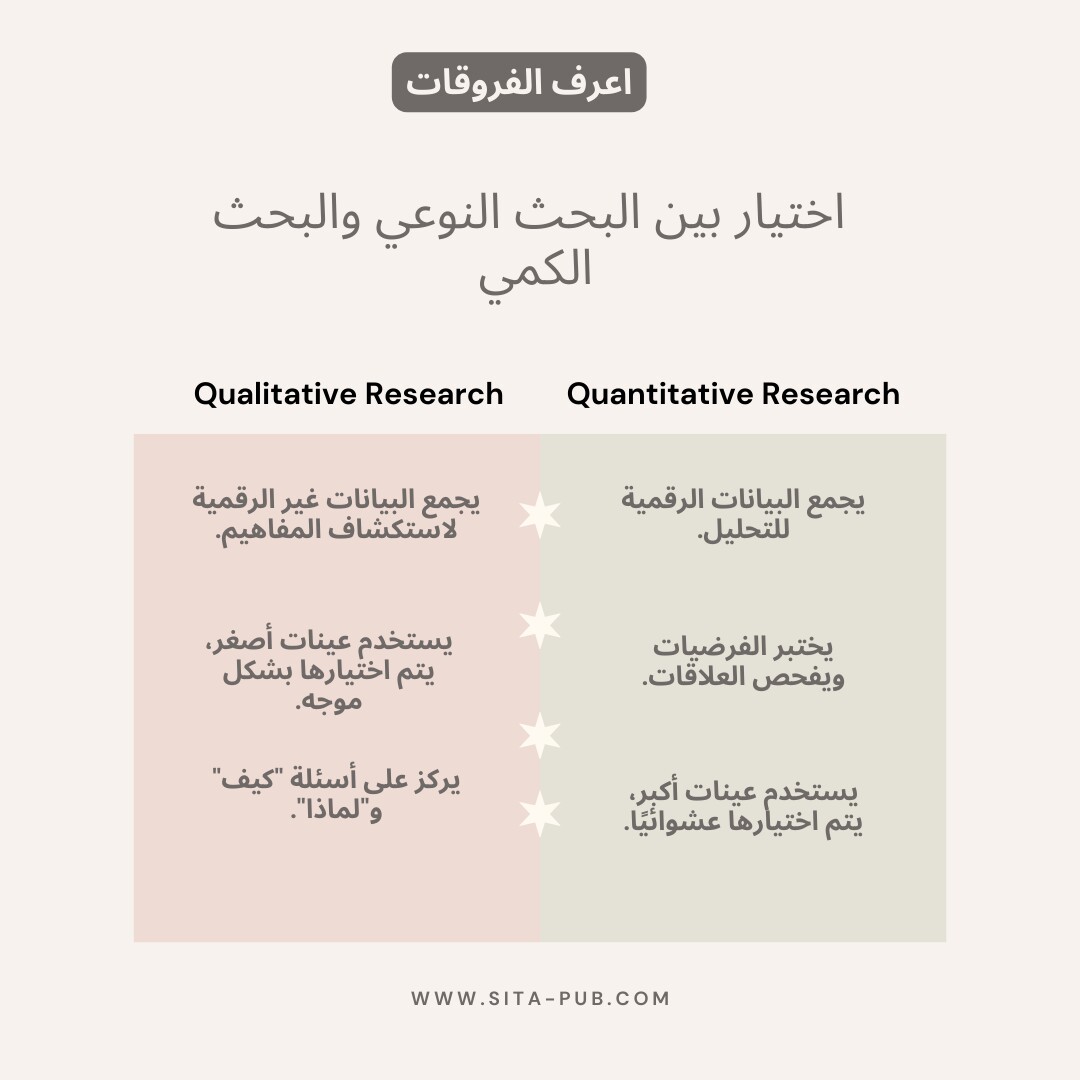اختیار بین البحث النوعی (Qualitative Research) والبحث الکمی (Quantitative Research)


عند بدء مشروع بحثی، أحد الاختیارات المهمه التی یجب أن تقوم بها هو تحدید ما إذا کنت ستستخدم الطرق البحثیه النوعیه (Qualitative Research) أو الکمیه (Quantitative Research). لکل منهما مزایا خاصه وهو مناسب لأنواع مختلفه من الأسئله. هنا، سنشرح العوامل الرئیسیه التی یجب مراعاتها عند اتخاذ هذا القرار.
یعد البحث النوعی الأنسب عندما ترغب فی استکشاف مواضیع معقده، وفهم مشاعر الناس، أو الحصول على رؤى مفصله. تتیح لک هذه الطریقه طرح أسئله مفتوحه وجمع القصص الشخصیه.
مثال: فهم مشاعر مرضى السرطان حول علاجهم.
یعد البحث الکمی أفضل عندما ترغب فی اختبار الأفکار، أو قیاس شیء ما، أو البحث عن أنماط. تستخدم هذه الطریقه الأرقام والإحصائیات لتحلیل البیانات.
مثال: اختبار مدى فعالیه دواء جدید فی تجربه سریریه.
استخدم البحث النوعی للأسئله التی تتطلب إجابات تفصیلیه. إذا کنت ترغب فی استکشاف "کیف" أو "لماذا" یحدث شیء ما، فهذه الطریقه مفیده.
مثال: "کیف یؤثر المؤثرون على وسائل التواصل الاجتماعی على ما یشتریه الناس؟"
اختر البحث الکمی للأسئله التی یمکن الإجابه علیها بالأرقام. إذا کنت ترغب فی معرفه ما إذا کان هناک علاقه أو فرق، فهذه الطریقه مناسبه.
مثال: "هل هناک علاقه بین استخدام وسائل التواصل الاجتماعی وإنفاق المال؟"
غالبًا ما یتضمن البحث النوعی المقابلات، مجموعات الترکیز، أو الملاحظات. تقدم هذه الأسالیب معلومات غنیه ووصفیه.
مثال: إجراء مقابلات مع المعلمین لفهم طرق تدریسهم.
یتضمن البحث الکمی عادهً الاستبیانات، التجارب، أو تحلیل البیانات الموجوده. توفر هذه الأسالیب بیانات رقمیه یمکن تحلیلها إحصائیًا.
مثال: تقدیم استبیان للطلاب لقیاس مدى رضاهم عن المدرسه.
یستخدم البحث النوعی عادهً مجموعات صغیره من الأشخاص الذین یتم اختیارهم لأسباب محدده. یرکز هذا النوع من البحث على جمع رؤى عمیقه بدلاً من کمیات کبیره من البیانات.
مثال: إجراء مقابلات مع 15 مشارکًا لمعرفه المزید عن صحه المجتمع.
یتطلب البحث الکمی مجموعات أکبر لضمان صحه النتائج وقابلیتها للتعمیم على السکان الأکبر. غالبًا ما یتم استخدام العینه العشوائیه.
مثال: إجراء استبیان مع 1,000 شخص لجمع الآراء حول سیاسه عامه.
فی البحث النوعی، یتم تحلیل البیانات من خلال تحدید الأنماط والمواضیع. یمکن أن یؤدی هذا إلى رؤى جدیده أثناء دراسه البیانات.
مثال: استخدام التحلیل الموضوعی للعثور على المواضیع المشترکه فی إجابات المقابلات.
یستخدم البحث الکمی الأسالیب الإحصائیه لتحلیل البیانات، مثل حساب المتوسطات أو العثور على علاقات بین المتغیرات.
مثال: استخدام اختبار t لمقارنه متوسطات مجموعتین.
یمکن أن یستغرق البحث النوعی وقتًا طویلاً بسبب الطبیعه العمیقه لجمع البیانات وتحلیلها. فکر فیما إذا کان لدیک الوقت والموارد الکافیه لإجراء مقابلات أو مجموعات ترکیز.
قد یتطلب البحث الکمی تخطیطًا أکبر لإنشاء استبیانات أو تجارب. ومع ذلک، بمجرد جمع البیانات، یمکن أن یکون تحلیلها أسرع.
البحث باستخدام الطرق المختلطه یجمع بین المنهجیات النوعیه (Qualitative) والکمیه (Quantitative) لتقدیم صوره أکثر شمولاً حول موضوع البحث.
مثال: دراسه عن رضا المرضى قد تستخدم استبیانات (بحث کمی) للحصول على التقییمات، بالإضافه إلى مقابلات متابعه (بحث نوعی) لفهم الأسباب وراء تلک التقییمات
المزایا:
یوفر معلومات غنیه ومفصله
مرونه فی جمع البیانات
یعکس وجهات نظر الأشخاص
العیوب:
یستغرق وقتًا أطول
من الصعب تعمیم النتائج
إمکانیه وجود تحیز من الباحث
المزایا:
دقیق إحصائیًا
یمکن تعمیم النتائج
أسهل فی التکرار
العیوب:
قد یفتقد السیاق المهم
أقل مرونه فی جمع البیانات
یمکن أن یبالغ فی تبسیط القضایا المعقده
إلیک دلیل بسیط لمساعدتک فی اتخاذ القرار بشأن الطریقه التی یجب استخدامها:
تعریف سؤال البحث : هل هو استکشافی (نوعی) أم تأکیدی (کمّی)؟
مراعاه الأهداف : هل ترغب فی الحصول على عمق (نوعی) أم شمولیه (کمّی)؟
تقییم الموارد المتاحه: هل لدیک الوقت والأدوات لإجراء مقابلات نوعیه أو استبیانات کمیه؟
تقییم الجمهور المستهدف: ما نوع البیانات التی ستتفاعل معها أکثر جمهورک المستهدف؟
اختیار البحث النوعی أو الکمی یعتمد على أهداف بحثک، وأسئلتک، والموارد المتاحه. کل طریقه توفر رؤى قیمه ویمکن أن تساهم بشکل کبیر فی مجالک البحثی. من خلال مراعاه هذه العوامل، یمکنک اختیار الطریقه التی تتناسب بشکل أفضل مع احتیاجات بحثک. سواء اخترت البحث النوعی أو الکمی أو استخدام أسلوب البحث المختلط، فإن فهم نقاط القوه والضعف لکل منها سیساعدک على اتخاذ قرارات مدروسه طوال عملیه البحث.
الجانب (Aspect) | البحث النوعی (Qualitative Research) | البحث الکمی (Quantitative Research) |
طبیعه البیانات (Nature of Data) | غیر رقمیه (کلمات، ملاحظات) | رقمیه (إحصائیات، قیاسات) |
ترکیز البحث (Research Focus) | استکشاف المعانی، "کیف" و "لماذا" | اختبار الفرضیات، "ما" و "کم" |
حجم العینه (Sample Size) | عینات أصغر، مختاره بشکل موجه | عینات أکبر، مختاره عشوائیًا |
طرق جمع البیانات (Data Collection Methods) | مقابلات، مجموعات ترکیز، ملاحظات | استبیانات، تجارب، تحلیل إحصائی |
تقنیات التحلیل (Analysis Techniques) | التحلیل الموضوعی، الترمیز | التحلیل الإحصائی (مثل اختبار t) |
المزایا (Advantages) | رؤى غنیه ومفصله | دقیق إحصائیًا، قابل للتعمیم |
العیوب (Disadvantages) | یستغرق وقتًا طویلاً، من الصعب تعمیم النتائج | قد یبسط الأمور بشکل مفرط، أقل مرونه |
الطرق المختلطه (Mixed Methods) | یجمع بین کلا المنهجین للحصول على عمق | یجمع بین کلا المنهجین للحصول على شمولیه |
لماذا تختار سیتا؟

إذا کان لدیک أی أسئله، استفسارات، أو ترغب فی معرفه المزید عن خدماتنا، فلا تتردد فی التواصل معنا. فریقنا المخصص مستعد لمساعدتک.